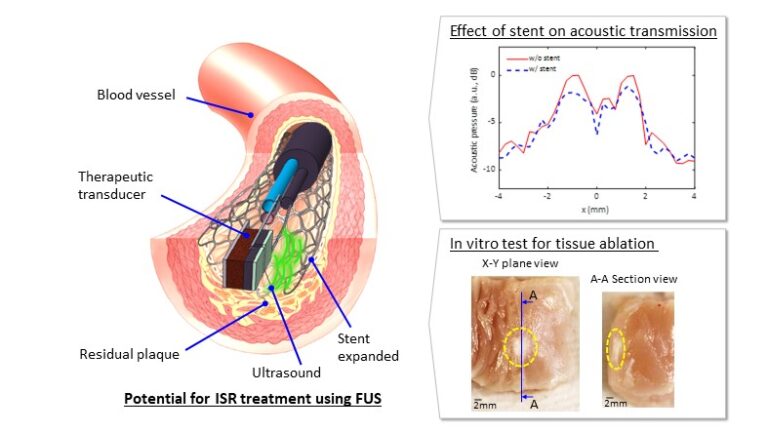Coronary artery disease (CAD) with severe stenosis or total occlusion of the coronary artery due to atherosclerotic plaque formation results in inadequate supply of blood and oxygen to the myocardium. Stenting is a common treatment to restore or improve coronary flow. However, in-stent restenosis (ISR) can develop due to new atherosclerotic plaque formation or intimal hyperplasia of the stented vessels and treatment of ISR remains challenging even with several modalities currently in clinical use. This study proposes a new modality for the relief of ISR using focused ultrasound (FUS) ablation.
Specifically, a miniaturized (<2.8 mm in diameter) intravascular FUS transducer for ISR treatment was designed through a structural-acoustic simulation, followed by the device prototyping and characterization to assess the transmission of acoustic energy over metallic stents through hydrophone tests. Finally, the prototype FUS transducer was used for the demonstration of tissue ablation with bio-tissues (chicken breasts) over metallic stents, which mimics in-stent tissue ablation. Moreover, a safety profile test was conducted by sonicating a controlled dose of ultrasound over porcine arterial tissue and detecting the thermal damage to the tissue.
The results show that the FUS device can deliver sufficient acoustic intensity (30 W/cm2) to the bio-tissue through the metallic stent. The ablation volume was approximately 3.9×7.8×2.6 mm3. In addition, we found that a sonication time of 1.5 minutes was enough to achieve an ablating depth of about 1.0 mm, without thermally damaging the underlying vessel. It is the first study to demonstrate the safety and therapeutic potential of sono-ablation for ISR treatment. The findings provide a key understanding of FUS therapy through metallic stents, which could become a novel approach to ISR treatment.

